
건축물 일체형 도시농업에서 딸기와 강낭콩 공영식재에 따른 생육 특성
Ⓒ The Korean Environmental Sciences Society. All rights reserved.
This is an Open-Access article distributed under the terms of the Creative Commons Attribution Non-Commercial License (http://creativecommons.org/licenses/by-nc/3.0) which permits unrestricted non-commercial use, distribution, and reproduction in any medium, provided the original work is properly cited.
Abstract
This study was conducted to obtain basic data on efficient and eco-friendly crop cultivation for urban residents who enjoy urban agriculture as a hobby or leisure activity. We planted strawberry(Fragaria x ananassa)(S) and kidney bean (Phaseolus vulgaris var. humilis)(K) in different ratios to analyze the differences in soil environment, growth, physiology, and productivity, and to investigate the effects. Strawberry growth was optimal with S1K2 ratio, whereas the S1K1 ratio treatment showed the highest levels of physiology and productivity. In terms of growth and physiology, kidney beans tended to perform best in S1K2 treatment. The average number of productive pods was two, with a highest average value of 2.3 being recorded in S2K1 treatment planted with a high percentage of strawberries. In terms of growth, physiology, and prodctivity our findings indicate that it would be desirable to plant starwberries and kidney bean in a 1:1 ratio. However, considering the environmental characteristics of walls and rooftops, it is necessary to effectively manage crops suitable for these conditions. Furthermore, additional studies should be conducted to analyze the quality of fruits and seeds producted, both qualitatively and quantitatively in the future.
Keywords:
Companion planting, Eco-friendly agriculture, Rooftop farming, Urban agriculture, Vertical farming1. 서 론
주말농장, 도시농업 등의 활동은 도시생활에 지쳐있는 시민들에게 여가생활과 커뮤니티의 장으로서 역할이 커지고 있다(Yang, 2015). 이러한 도시농업의 사회적 가치는 친환경적이고 지속 가능한 농법의 필요성을 더욱 강조한다. 도시농업의 육성 및 지원에 관한 법률에서 도시농업은 도시 지역의 토지, 건축물 등 다양한 공간에서 작물을 경작 및 재배하는 행위라고 정의하고 있다. 현대인들은 도시의 부족한 녹지 공간으로 인해 개인의 텃밭, 옥상, 베란다, 주말농장 등의 형태로 작물을 재배하고 있다고 한다(Cha, 2017).
현대인들의 농업에 대한 관심이 증가하면서 힐링 등 도시민의 사회적 성취 욕구를 충족하기 위한 방안으로 경작이 대두되고 있다(Kim, 2018). 스스로 작물을 재배 및 수확하여 먹거리를 생산하고 소비하려는 도시민의 욕구에 반해 좁은 경지면적과 과도한 화학비료의 사용으로 친환경 농법을 실천하기 위한 여건은 열악한 실정이다(Jung, 2022). 친환경 농법의 중요성에 대한 관심이 증가하며 공영식물을 이용한 작물 재배가 그 대안으로 제시되고 있다.
공영식재(Companion planting)는 단일식재와 달리 두 종 이상의 식물을 식재함으로써 각 작물의 특성이 서로에게 영향을 주고 받으며 이익을 얻을 수 있는 식재방법으로(DeJong, 2017) 작물을 효율적으로 유지관리하기 위한 친환경 농법으로 주목받고 있다. 콩과식물을 공영식재로 이용한 연구에서 Verret et al. (2017)은 잡초 방제효과를 확인하였고 Saldanha et al. (2019)은 해충 발생 억제 및 익충 유인의 효과를 검증하였다. Wasi(2019)의 연구에서 콩은 질소 고정능력이 있어 단백질 함량이 적은 옥수수와 함께 공영식물로 이용된다고 하였다. 국내에서는 허브류, 채소류, 화훼류 등의 식물을 선정하여 배추과 식물과 혼식재배하는 조합을 통해 해충의 피해 정도 및 작물 생육에 미치는 영향을 조사하였다(Chae et al., 2019). 하지만 우리나라에서는 아직 생소한 기법으로 (Kim et al., 2013), 수종이 한정적이며 식재 비율에 관한 연구는 미비한 실정이다.
딸기(Fragaria x ananassa)는 전세계적으로 재배되는 작물로 우리나라 채소 산업에서 중요한 고소득 작물로 평가받고 있다(Park et al., 2017). 강낭콩(Phaseolus vulgaris var. humilis)은 대기 중에 존재하는 질소를 고정하여 생물이 이용할 수 있도록 전환이 가능한 뿌리혹박테리아와 상리공생한다고 알려져 있다 (Cho et al., 2020). 딸기와 강낭콩 두 작물 모두 식용이 가능하다는 점을 고려해 도시농업을 위한 공시식물로 선정하였다.
본 연구는 도시 내 건축물에서 딸기와 강낭콩의 공영식재가 서로의 생육, 생리 및 생산성에 어떠한 상호작용을 하는지를 평가하는 것이다. 이를 통해 도시농업인에게 보다 효율적인 작물 재배방법을 제공할 수 있는 기초자료를 마련하고자 한다.
2. 범위 및 방법
2.1. 연구재료
본 연구에 사용된 공시 토양은 펄라이트(New–perls hine, GHC, Korea)를 배수층으로 사용하였으며, 식재기반으로는 원예용 상토인 한판승(한판승, Samhwa, Korea)을 사용하였다. 식물재료는 2023년 5월에 충주에 위치한 농약사에서 직경 약 9 cm 화분의 딸기(Fragaria x ananassa)와 72구 육묘트레이의 강낭콩(Phaseolus vulgaris var. humilis)을 구입한 후 2주간 온실에서 순화시켰다.
본 실험은 2023년 5월부터 7월까지 수행하였으며, 전공 온실 벽면과 복합실습동 옥상에서 실시하였다. 실험기간 환경조건은 입면에서 평균 23.6℃, 습도 75.6%로 조사되었고 옥상에서 평균 27℃, 습도는 66.6%를 기록했다. 실험구의 크기는 가로 60 cm, 세로 20 cm, 높이 15 cm의 화분을 이용하였고 식재지반은 화분에 부직포(Non-woven fabric, CG, Korea)를 깔고 펄라이트 2 cm, 원예용 상토 12 cm를 차례대로 포설하였다. 딸기(Fragaria x ananassa)와 강낭콩(Phaseolus vulgaris var. humilis)을 Control 1, 2:1, 1:1, 1:2, Control 2의 비율로 나누어 처리구별로 12본을 식재하였고 3반복하여 입면 15구, 옥상 15구의 실험구를 조성하였다. 관수는 토양이 마르지 않도록 3일에 한번 실시하였다.
2.2. 연구방법
토양양분함량은 토양에 함유된 질소(N, Nitrogen), 인(P, Phosphorus), 칼륨(K, Kalium)등을 토양성분측정기(SOIL6CH, Testauction, China)을 이용하였다. 조사는 2주에 한 번 실험구당 3반복 측정하였고 평균값을 산출하였다.
생육실험은 실험구에 정식 후 14일이 경과한 날부터 초장, 엽장, 엽폭은 자를 이용하였고 엽수는 육안으로 측정하였다. 상대엽록소함량은 휴대용 엽록소 측정기(SPAD-502, Mitutoyo, Japan)를 이용하였고 생체중과 건물중은 미세전자저울(FX-200i, AND, Korea)과 열풍순환건조기(C-DF, Changshin Sci, Co., Korea)에 70℃의 온도에서 72시간 건조하였다. 과실수, 포복경, 꼬투리 수는 육안으로 측정하였다.
본 연구의 통계분석은 SPSS Statistic 25(SPSS Inc, Chicago, IL USA) 프로그램을 사용했다. 공영식재에 따른 실험구별 유의성 확인을 위해 일원배치 분산분석을 이용하였으며 사후검정으로 Duncan 다중검정을 p<0.05 수준에서 수행하였다.
3. 결과 및 고찰
3.1. 토양양분함량
실험기간 중 딸기와 강낭콩 공영식재에 따른 토양 내 질소 함량의 변화는 Fig. 1과 같다. 토양 질소 함량은 입면보다 옥상에서 많은 것으로 나타났다. 입면은 딸기 단일식재 실험구에서 가장 많았으며 옥상은 딸기의 비율이 높은 실험구 S2K1에서 가장 많은 질소 함량을 확인할 수 있었다. 인과 칼륨 함량은 벽면에서 많은 것으로 나타났고 옥상과 입면 모두 강낭콩 단일식재인 KC에 비해 딸기 단일식재인 SC와 딸기와 강낭콩 공영식재 실험구인 S2K1, S1K1, S1K2에서 높게 측정되었다. 공영식재 실험구 중에서는 딸기와 강낭콩의 비율이 같은 S1K1실험구에서 가장 높았다(Fig. 2, Fig. 3).
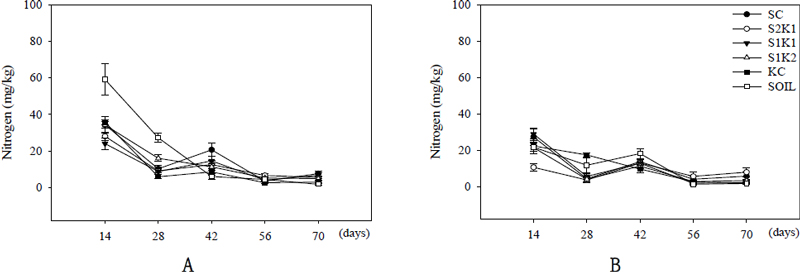
Nitrogen content of strawberry and kidney bean soil according to the ratio of companion planting in urban agriculture. Each value in the figure is the mean and the vertical bars give the standard error(SE). A: Wall, B: Roof, SC: Strawberry control, S2K1: Strawberry : Kidney bean = 2:1, S1K1: Strawberry : Kidney bean = 1:1, S1K2: Strawberry : Kidney bean =1:2, KC: Kidney bean control, SOIL: Soil control.
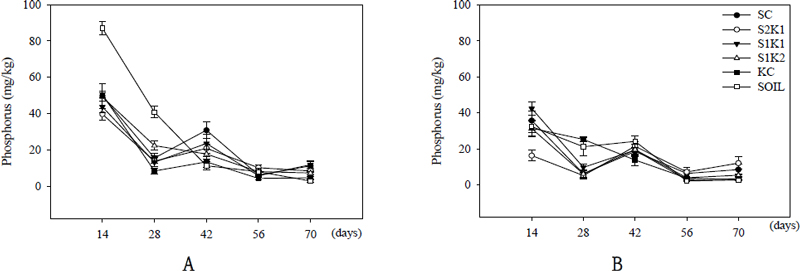
Phosphorus content of strawberry and kidney bean soil according to the ratio of companion planting in urban agriculture. Each value in the figure is the mean and the vertical bars give the standard error(SE). A: Wall, B: Roof, SC: Strawberry control, S2K1: Strawberry : Kidney bean = 2:1, S1K1: Strawberry : Kidney bean = 1:1, S1K2: Strawberry : Kidney bean =1:2, KC: Kidney bean control, SOIL: Soil control.
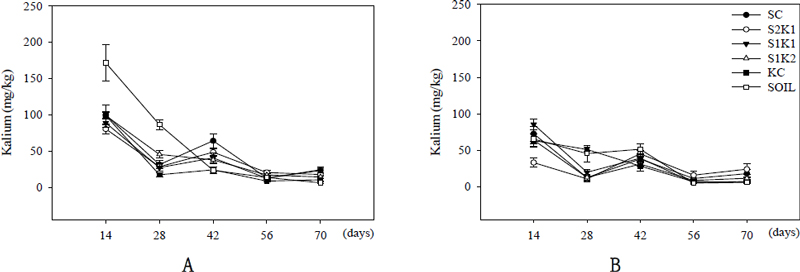
Kalium content of strawberry and kidney bean soil according to the ratio of companion planting in urban agriculture. Each value in the figure is the mean and the vertical bars give the standard error(SE). A: Wall, B: Roof, SC: Strawberry control, S2K1: Strawberry : Kidney bean = 2:1, S1K1: Strawberry : Kidney bean = 1:1, S1K2: Strawberry : Kidney bean =1:2, KC: Kidney bean control, SOIL: Soil control.
3.2. 식물생육 및 생리, 생산성
식물 생육 중 초장은 입면에서 더 높은 것으로 나타났다(Fig. 4). 딸기는 온도가 높을수록 생육이 저하된다고 알려져 있다(Kim et al., 2005). 이와 같은 결과는 옥상에서의 온도가 입면에서보다 높았기 때문이라고 사료된다. 입면과 옥상 모두 강낭콩의 비율이 높은 실험구(S1K2)에서 초장이 가장 길었다. 엽장, 엽폭도 입면에서 더 길게 측정되었으며 엽장은 강낭콩의 비율이 높은 S1K2에서(Fig. 5), 엽폭은 딸기와 강낭콩의 비율이 같은 S1K1 실험구에서 가장 길게 나타났다(Fig. 6). 잎은 기온이 높을수록 성장이 저하된다는 선행연구에 따라(Lee et al., 2019), 초장과 마찬가지로 옥상의 평균 기온이 입면보다 높아 잎의 성장에 영향을 미친 것으로 판단된다. 딸기의 엽수는 옥상에서 더 많은 것을 확인할 수 있었는데, 입면과 옥상 모두 딸기와 강낭콩의 비율이 같은 S1K1 실험구에서 가장 많은 것으로 분석되었다(Fig. 7).

Plant height of strawberry and kidney bean according to the ratio of companion planting in urban agriculture. Each value in the figure is the mean and the vertical bars give the standard error(SE). A: Wall, B: Roof, SC: Strawberry control, S2K1: Strawberry : Kidney bean = 2:1, S1K1: Strawberry : Kidney bean = 1:1, S1K2: Strawberry : Kidney bean =1:2.
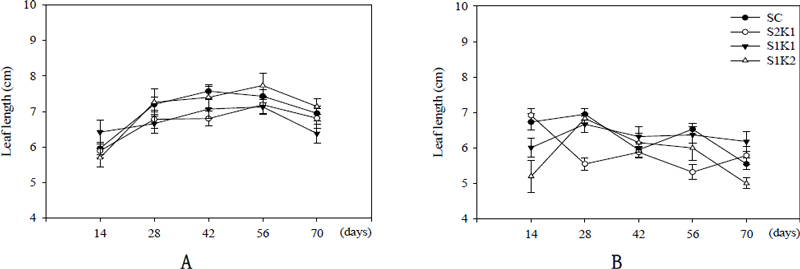
Leaf length of strawberry and kidney bean according to the ratio of companion planting in urban agriculture. Each value in the figure is the mean and the vertical bars give the standard error(SE). A: Wall, B: Roof, SC: Strawberry control, S2K1: Strawberry : Kidney bean = 2:1, S1K1: Strawberry : Kidney bean = 1:1, S1K2: Strawberry : Kidney bean =1:2.
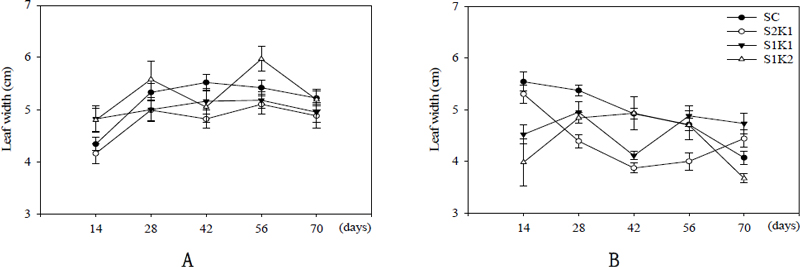
Leaf width of strawberry and kidney bean according to the ratio of companion planting in urban agriculture. Each value in the figure is the mean and the vertical bars give the standard error(SE). A: Wall, B: Roof, SC: Strawberry control, S2K1: Strawberry : Kidney bean = 2:1, S1K1: Strawberry : Kidney bean = 1:1, S1K2: Strawberry : Kidney bean =1:2.

Number of leaves of strawberry and kidney bean according to the ratio of companion planting in urban agriculture. Each value in the figure is the mean and the vertical bars give the standard error(SE). A: Wall, B: Roof, SC: Strawberry control, S2K1: Strawberry : Kidney bean = 2:1, S1K1: Strawberry : Kidney bean = 1:1, S1K2: Strawberry : Kidney bean =1:2.
딸기의 생리 중 상대엽록소함량은 입면의 딸기와 강낭콩의 비율이 같은 S1K1 실험구에서 가장 높게 나타났다(Fig. 8). 딸기의 생체중은 입면 지상부는 S1K1, 지하부는 S2K1에서 가장 높았고 옥상은 지상부 S1K1, 지하부 SC 실험구에서 가장 무거운 것으로 분석되었으며 입면보다 옥상에서의 딸기 생체중이 높게 나타났다(Fig. 9). 딸기의 건물중은 입면에서 지상부는 SC, 지하부는 S1K1, 옥상은 지상부와 지하부 모두 SC에서 가장 무거웠음을 알 수 있었다(Fig. 10).

Chlorophyll contents of strawberry and kidney bean according to the ratio of companion planting in urban agriculture. Each value in the figure is the mean and the vertical bars give the standard error(SE). A: Wall, B: Roof, SC: Strawberry control, S2K1: Strawberry : Kidney bean = 2:1, S1K1: Strawberry : Kidney bean = 1:1, S1K2: Strawberry : Kidney bean =1:2.

Fresh weight of strawberry and kidney bean according to the ratio of companion planting in urban agriculture. Each value in the figure is the mean and the vertical bars give the standard error(SE). Different alphabets indicate differences in mean values from Duncan's multiple range test at 5% level. A: Wall, B: Roof, SC: Strawberry control, S2K1: Strawberry : Kidney bean = 2:1, S1K1: Strawberry : Kidney bean = 1:1, S1K2: Strawberry : Kidney bean =1:2.
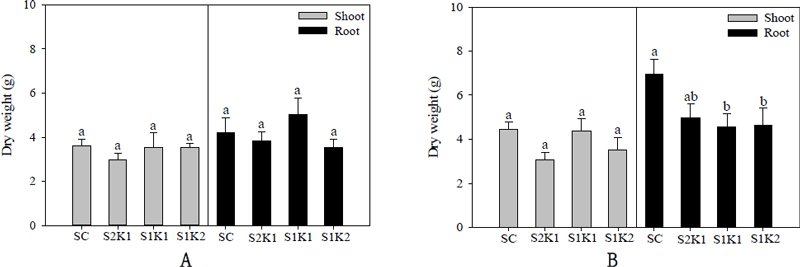
Dry weight of strawberry and kidney bean according to the ratio of companion planting in urban agriculture. Each value in the figure is the mean and the vertical bars give the standard error(SE). Different alphabets indicate differences in mean values from Duncan's multiple range test at 5% level. A: Wall, B: Roof, SC: Strawberry control, S2K1: Strawberry : Kidney bean = 2:1, S1K1: Strawberry : Kidney bean = 1:1, S1K2: Strawberry : Kidney bean =1:2.
딸기의 과실수는 맺힌 딸기 중 80 % 이상 성숙되었다고 판단되는 개체의 수를 측정한 것으로, 입면에서는 딸기의 비율이 높은 S2K1 실험구에서 가장 많았고 옥상에서는 딸기 단일식재인 SC에서 가장 많았다(Fig. 11). 옥상에서의 과실수가 입면보다 많은 것으로 측정되었다. 딸기는 포복경에 의한 번식을 하는 작물로서 토양 표면을 따라 수평으로 자라는 줄기를 말한다(Zhao et al., 2020). 포복경은 입면과 옥상 모두 딸기와 강낭콩의 비율이 같은 S1K1 실험구에서 가장 많았다(Fig. 12).
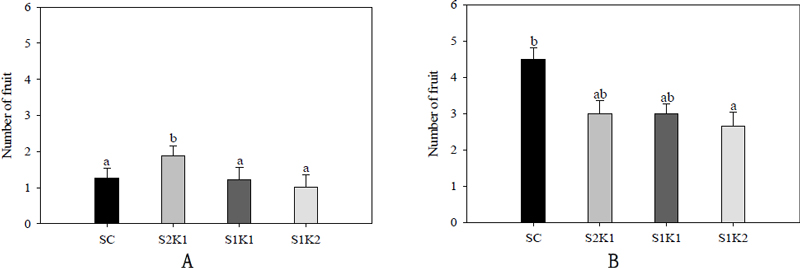
Number of furit of strawberry and kidney bean according to the ratio of companion planting in urban agriculture. Each value in the figure is the mean and the vertical bars give the standard error(SE). Different alphabets indicate differences in mean values from Duncan's multiple range test at 5% level. A: Wall, B: Roof, SC: Strawberry control, S2K1: Strawberry : Kidney bean = 2:1, S1K1: Strawberry : Kidney bean = 1:1, S1K2: Strawberry : Kidney bean =1:2.
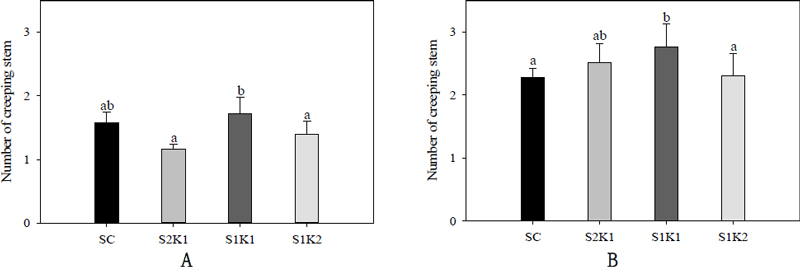
Number of creeping stem of strawberry and kidney bean according to the ratio of companion planting in urban agriculture. Each value in the figure is the mean and the vertical bars give the standard error(SE). Different alphabets indicate differences in mean values from Duncan's multiple range test at 5% level. A: Wall, B: Roof, SC: Strawberry control, S2K1: Strawberry : Kidney bean = 2:1, S1K1: Strawberry : Kidney bean = 1:1, S1K2: Strawberry : Kidney bean =1:2.
강낭콩의 생육 중 초장은 입면의 강낭콩 비율이 높은 실험구에서 가장 긴 것으로 나타났다. 엽장과 엽폭도 입면의 강낭콩 비율이 높은 S1K2에서 가장 높았으며 엽수는 입면과 옥상 중 옥상에서 딸기의 비율이 높은 S2K1에서 많은 경향을 보였다. 강낭콩의 꼬투리수는 평균적으로 2개였으며 그 중 옥상에서 강낭콩의 비율이 높은 실험구가 2.3개로 가장 많이 측정되었다(Table 1).
강낭콩의 생리 중 생체중은 지상부, 지하부 모두 강낭콩 단일식재에서 가장 무거웠음을 알 수 있었다. 건물중 지상부는 옥상의 딸기와 강낭콩 비율이 같은 S1K1에서 가장 높았고 지하부는 강낭콩 단일식재 KC에서 가장 무거웠다. 상대엽록소함량은 입면보다 옥상에서 전체적으로 높은 값을 나타내었고 그 중 강낭콩 단일식재에서 가장 높게 측정되었다(Table 2).
4. 결 론
본 연구는 도시 내에서 건축물을 활용하여 친환경적인 여가활동 및 효율적인 작물 생산을 위해 딸기와 강낭콩의 식재비율에 따른 작물의 생육, 생리 및 생산성을 평가하여 도시농업의 기초자료로 제시하고자 진행되었다. 실험구는 딸기와 강낭콩의 공영식재 비율에 따라 각각 SC, S2K1, S1K1, S1K2, KC로 분류하였으며 2023년 5월부터 7월까지 진행되었다.
딸기의 생육 결과를 분석했을 때, 벽면과 옥상 모두에서 딸기의 비율이 높은 S2K1 실험구에서 초장과 엽장이 상대적으로 길었다는 것을 발견했다. 이는 딸기의 생육에 강낭콩이 어떤 영향을 미치는지에 대한 추가적인 분석이 필요함을 시사한다. 엽폭은 강낭콩 비율이 높을수록 더 길었고 입면이 옥상보다 큰 값을 나타내었다. 엽수는 입면, 옥상 모두 딸기와 강낭콩 비율이 같은 S1K1 실험구에서 가장 많았다. 종합적으로 분석했을 때, 딸기의 생육은 입면의 딸기의 비율이 높을수록 생육이 좋은 것으로 나타났다.
딸기 생리의 경우, 상대엽록소함량은 입면의 딸기와 강낭콩 비율이 같은 S1K1 실험구가 가장 높았다. 생체중과 건물중은 옥상의 딸기 단일식재 실험구에서 가장 무거웠고 공영식재 실험구 중에서는 딸기와 강낭콩의 비율이 같은 S1K1 실험구에서 높게 분석되었다.
딸기의 생산성에 대한 관찰에서, 과실수와 포복경이 입면보다 옥상에서 더 높은 값을 보였다. 이는 기존 연구에서 관찰된 도시농업 환경의 영향과 비교하여 논의될 필요가 있다. 과실수는 딸기 단일식재에서 가장 많았으나 공영식재 실험구 중 S2K1과 S1K1 실험구에서 가장 많았다. 포복경의 경우 딸기와 강낭콩 비율이 같은 S1K1에서 가장 많았으며 옥상에서 더 많은 포복경을 확인할 수 있었다.
강낭콩의 경우, 초장, 엽장, 엽폭은 입면에서 강낭콩 비율이 높은 S1K2 실험구에서 가장 길었다. 엽수는 입면과 옥상의 차이가 크게 나타났고 옥상에서 더 많은 엽수를 확인할 수 있었으며 딸기의 비율이 높은 S2K1에서 가장 많았다. 강낭콩의 생산성인 꼬투리수는 옥상의 강낭콩 비율이 높은 실험구가 가장 많은 것으로 측정되었다.
종합적으로 분석했을 때, 딸기와 강낭콩을 1 : 1 비율로 식재하는 것이 생육, 생리 및 생산성 측면에서 가장 바람직하다고 판단된다. 그러나 이러한 결과는 주어진 실험 조건에 국한된 것으로, 다양한 환경 조건에서의 추가 연구가 필요함을 인지해야 한다. 본 연구는 지속가능한 친환경 농업의 확대와 그린힐링을 실천할 수 있는 방안을 제시한다는 점에서 의의를 가진다. 하지만 표본수가 적고 유의미한 차이를 보이지 않은 항목이 존재한다는 한계가 있다. 또한 건축물을 활용하는 특수한 환경의 특성상 이에 맞는 작물의 효과적인 관리방안이 제시되어야 할 것으로 사료되며 공영식재와 이에 대한 식재밀도에 관해 추후 연구가 진행되어야 할 것이다.
Acknowledgments
이 성과는 정부(과학기술정보통신부)의 재원으로 한국연구재단의 지원을 받아 수행된 연구임 (No. 2021R1F1A1063456)
References
- Cha, M. K., 2017, Efficient gardening utilizing the rooftop in the city, Graduate School of Silla University.
- Chae, Y., Hong, I. K., Lee, S. M., Jung, Y. B., Han, K. S., Jang, Y. A., Youk, S. H., 2019, Effects of mixed cultivation of companion plant in urban garden on the pest development and growth of Cabbages, Korean Horticultural Society, 37, 75-76.
- Cho, A., Lee, J. H., 2020, Isolation and characterization of Nitrogen-fixing bacteria from root nodules of leguminous plants and nodulation test, The Korean Society of Environmental Agriculture, 2020, 237-237.
- DeJong, D., 2017, Companion planting: Effects of radishes on squash bugs, Environmental Studies Undergraduate Student Theses, 216.
- Jung, H. C., 2022, Analysis of use status and improvement tasks for Environment-Friendly agricultural materials, Chonnam National University.
-
Kim, M. J., Sim, C. K., Kim, Y. K., Ji, H. J., Yoon, J. C., Park, J. H., Han, E. J., Hong, S. J., 2013, Effect of Inter-and mixed cropping with Attractant and Repellent Plants on Occurrence of Major Insect Pests in Organic Cultivation of Chinese Cabbage, Korea Journal of Organic Agriculture, 21, 685-699.
[https://doi.org/10.11625/KJOA.2013.21.4.685]

- Kim, S. A., 2018, The influence of the characteristics of urban vegetable garden on satisfaction : Focusing on City of Ulsan, Pai Chai University.
- Kim, T. I., Jang, W. S., Park, S. G., Lee, S. S., 2005, Effect of shading on growth and quality of fruit in Straw-berry ‘Maehyang’, Korean Horticultural Society, 23, 50-50.
-
Lee, J. G., Jeong, Y. K., Yoon, Y. C., 2019, Characteristics of leaf temperature in greenhouse Strawberry based on light intensity and relative humidity, 54, 91-98.
[https://doi.org/10.14397/jals.2020.54.1.91]

- Park, G. H., Choi, G. S., Weon, G. H., Kim, S. J., Hwang, M. R., Kang, N. J., 2017, Effect of application of exogenous nitric oxide on growth in Strawberry, Korean Horticultural Society, 2017, 59-60.
-
Saldanha, A. V., Gontijo, L. M., Carvalho, R. M. R., Vasconcelos, C. J., Corrêa, A. S., Gandra, R. L. R., 2019, Companion planting enhances pest suppression despite reducing parasitoid emergence, Basic and Applied Ecology, 41, 45-55.
[https://doi.org/10.1016/j.baae.2019.10.002]

-
Verret, V., Gardarin, A., Pelzer, E., Médiène, S., Makowski, M., Valantin-Morison, M., 2017, Can legume companion plant control weeds without decreasing crop yield; A meta-analysis, Field Crops Research, 204, 158-168.
[https://doi.org/10.1016/j.fcr.2017.01.010]

- Wasi, F. D., 2019, Evaluation of forage productivity, quality and soil chemical composition through intercropping maize and Soybean, The Graduate School Kyungpook National University.
- Yang, W. C., 2015, A Study on the introduction of LED lighting to vertical farm for urban agriculture, The Korean Society of Design Culture, 21, 335-345.
-
Zhao, J., Li, Y., Park, Y. G., Hu, J., Jeong, B. R., 2020, Runner Training Angle Affects Growth of Runners in ‘Seolhyang’ and ‘Maehyang’ Strawberries, Journal of Bio-Environment Control, 29, 231-238.
[https://doi.org/10.12791/KSBEC.2020.29.3.231]

Department of Green Technology Convergence, College of Science & Technology, Konkuk Universitybbe_hyeona@naver.com
Department of Green Technology Convergence, College of Science & Technology, Konkuk Universitydianau@kku.ac.kr
Department of Green Technology Convergence, College of Science & Technology, Konkuk Universityyonghan7204@kku.ac.kr
Department of Green Technology Convergence, College of Science & Technology, Konkuk Universityjjhkkc@kku.ac.kr
